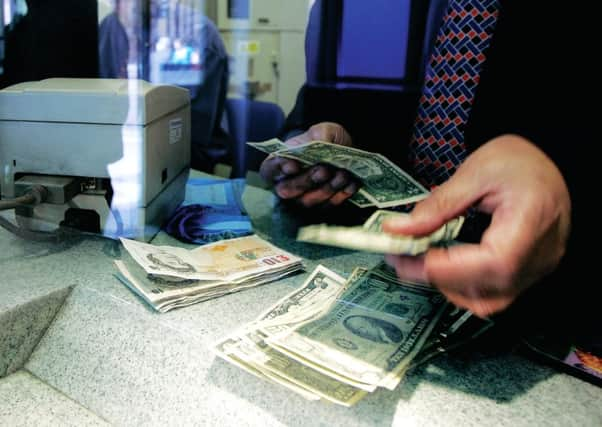Bill Jamieson: Resurgent pound raises questions


A striking irony in the rammy over SNP demands that an independent Scotland should be allowed to share the UK currency is the recent behaviour of sterling in currency markets. It has hit a near five-year high against the dollar, raising worries that its strength could kill off any broadening of the economic recovery.
It is just this sort of currency resurgence, working to drive up the costs of goods and services we sell overseas, that puts a question mark over hopes for the export-led recovery that we desperately need.
Advertisement
Hide AdAdvertisement
Hide AdOur balance of payments performance has been dire. Last year saw an eye-watering current account deficit of just over £71 billion. That’s equivalent to 4.4 per cent of GDP and worryingly close to the all-time record scored in 1989 – just before the onset of a sharp recession.
Latest figures have shown a marginal improvement: the trade deficit in February shrank to “just” £9.1bn from £9.4bn the previous month. But this fractional improvement was due to falling imports, not higher exports.
Nevertheless, the hope has to be that exports will increasingly benefit from global growth gradually picking up over the coming months.
The overall trade deficit in goods and services for February was £2.1bn, compared with a £2.2bn deficit a month earlier, thanks to the UK’s trade surplus in its dominant services sector.
The International Monetary Fund has judged our exports as well as business investment in the UK to be disappointing, despite raising its forecast for economic growth in the UK this year to 2.9 per cent, while David Kern, chief economist at the British Chambers of Commerce, has said it will be “incredibly hard” to meet Prime Minister David Cameron’s target of increasing exports to £1 trillion by 2020.
The UK currency has been drawing strength from recent upbeat surveys from the CBI and a further uptick in the Markit/Cips manufacturing purchasing managers’ index to 57.3 from a revised 55.8 in March – the highest for five months. Markit economist Rob Dobson says the survey suggests manufacturers are creating jobs at a pace of about 10,000 a month.
The latest CBI industrial trends survey is particularly noteworthy, pointing to another strong performance in the second quarter. The latest hard data shows that manufacturing output jumped 1 per cent month-on-month in February.
The survey shows a substantial pick-up in manufacturers’ investment intentions for plant and machinery and encouraging plans for investment in product and process innovation and in training. This, says Global Insight economist Howard Archer, “adds to mounting evidence that business investment is increasingly kicking in to help UK growth become more balanced”.
Advertisement
Hide AdAdvertisement
Hide AdA balance of plus 21 per cent of manufacturers say they have seen their total orders rise over the past three months, while a balance of plus 26 per cent expect their orders to rise over the next three months.
All this sounds very encouraging. And the hope is that it will blossom into a fully fledged export boom. But so far this recovery has signally failed to ignite a resurgence in exports of the type normally associated with early-stage recovery.
The absence is particularly glaring this time around, given the fall in sterling during the financial crisis. It is still some 15 per cent lower than before the crisis, but with little sign of an export upswing on the scale of that seen at this stage in past recoveries. Now a rallying pound, combined with as yet little improvement in productivity, puts a question mark next to hopes of an export-driven improvement.
Over the past 15 years, services – especially financial services – have helped to underpin sterling, adding to the pressures on the manufacturing sector. Since 1998, manufacturing’s share of GDP has shrunk some 44 per cent, compared with 36 per cent in France, 35 per cent in Canada and 24 per cent in the United States. It is now down to just 10 per cent of UK GDP. And the greater the shrinkage, the more daunting it is for manufacturing to deliver that export contribution and economic rebalancing that we need to see. For the moment our deficit in net trade continues to be the biggest drag on the UK’s overall GDP performance.
The strength of sterling has confounded those who have doubted the firmness of the UK recovery. It has remained unruffled, so far, by projections of the rising costs of North Sea oil and gas production and lower revenues from this source. And it has defied, so far, concerns that a Yes vote in Scotland’s independence referendum would trigger a sell-off in currency markets.
Setting aside last week’s warnings from rating agency Moody’s about an independent Scotland’s credit rating, one implication that would concern overseas investors is the effect a UK break-up would have on the debt rating for the rest of the UK. A separation, by taking Scotland’s GDP share out of the UK total, would have the effect of raising the rUK’s debt-to-GDP ratio uncomfortably close to 100 per cent of GDP. That’s a level that would unnerve many holders of sterling assets. But, for the moment, markets have turned a blind eye to poll readings suggesting a very close result and are assuming a No vote.
So for now the pound rides high – and the pressure now is on exporters to do everything possible to lift their productivity performance. «